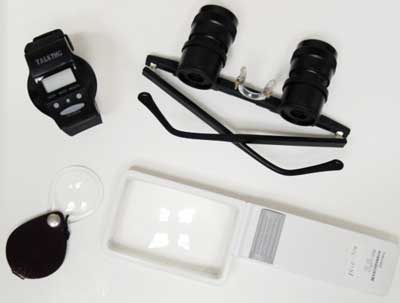Low Vision Rehabilitation
The Veterans Health Administration (VHA) recognizes the importance of providing blind and low vision rehabilitation care to Veterans. From now to the year 2020, VHA estimates that there will be almost one million severely visually impaired Veterans.
VHA Optometry Service offers a wide variety of services along the continuum of visual impairment ranging from primary eye and low vision care to Visual Impairment Center to Optimize Remaining Sight (VICTORS) programs and Blind Rehabilitation Centers (BRCs). Optometrists strive to help visually impaired Veterans maintain functionality and independence by addressing visual problems, determining goals, and evaluating specialized devices to aid Veterans in achieving those goals.
Vision loss can have a great impact on a person's ability to perform routine activities of daily living. Functional losses may include decreased ability to read or recognize faces, problems with paying bills, writing checks and taking care of personal finances, difficulty with watching television, cooking, and participating in hobbies or avocational activities. Vision loss can have a profound effect on mobility, with the loss of ability to drive, or worse, the loss of safe ambulation. A significant problem for elderly Veterans may be the inability to self-medicate because of the inability to read the labels on medicine bottles.
Optometrists evaluate decreased distance vision, decreased near vision, central vision loss, peripheral vision loss, reduced contrast sensitivity, and problems with photophobia, glare, and lighting. A variety of low vision devices may be prescribed for the visually impaired Veteran, including specialized lens designs and prescriptions, illuminated and non-illuminated stand, pocket and hand held magnifiers, prismatic eyeglasses, telescopes, special lighting, tints and filters, non-optical devices, and electronic devices such as Closed Circuit Televisions (CCTVs) and head-mounted displays.
VHA Optometry Service strives to contribute to the care of visually impaired Veterans through advanced training of clinicians in low vision rehabilitation in established Optometry Residency Programs. Many VA optometrists are actively involved in research pertaining to vision loss and vision rehabilitation, and some are renowned national leaders and educators in the field of low vision rehabilitation.

Low vision devices include hand-held magnifiers, telescopes and a talking watch.
Statutory Blindness and Legal Blindness Determination:
- Social Security Administration Disability Evaluation for 2.00 Special Senses and Speech – Adult
- Benefits - Veterans Benefits Administration Home Page
- Measurement of Eye Muscle Function: VBA Compensation Service Bulletin, September 2013
- Visual Field Testing: VBA Compensation Service Bulletin Policy (211), April 2013
Low Vision Policies and Related Publications:
- Accreditation of VHA Rehabilitation Programs, VHA Directive 1170.01 [see paragraph 6b(7)]
- Blind and Visual Impairment Rehabilitation Continuum of Care, VHA Directive 1174
- Case Management Standards of Practice, VHA Handbook 1110.04
- Catastrophically Disabled Veteran Evaluation, Enrollment, and Certain Copayment Exemptions, VHA Directive 1630(1)
- CCTVs and Electronic Optical Enhancement Devices
- Commission on Accreditation of Rehabilitation Facilties (CARF) Accreditation Note: Links to a website outside VA
- Copayment for Outpatient Medical Care Provided to Veterans by the Department of Veterans Affairs, VHA Directive 2011-022
- GAO Report on Outpatient Rehabilitation Services (GAO-04-996T)
- Animals on Veterans Health Administration (VHA) Property, VHA Directive 1188
- Low Vision Clinical Practice GuidelinesNote: Links to a website outside VA
- Low Vision Quick Reference Guide Note: Links to a website outside VA
- Optical Devices for Adults with Low Vision: A Systematic Review of Published Studies of Effectiveness
- PCMP CPRs for Prescription and Provision of Optical Low-Vision Devices
- PCMP CPRs for Prescription and Provision of Daily Living & Mobility Devices
- PCMP CPRs for Audible Prescription Reading Devices
- Polytrauma System of Care, VHA Directive 1172.01
- Prescribing Eyeglasses, Contacts Lenses, and Hearing Aids, VHA Directive 1034
- Screening and Evaluation of Possible Traumatic Brain Injury in OEF/OIF Veterans, VHA Directive 2010-012
- TBI Clinical Products/Recommendations from Defense Centers of Excellence for Psychological Health & Traumatic Brain Injury (see TBI sections of DCoE Resource Catalog)
- TBI-Specific Ocular Health and Visual Functioning Examinations for PRC Patients, VHA Directive 2008-065
- Vision Center of Excellence (VCE) Clinical Practice Recommendations
- VCE Clinical Recommendation for the Eye Care Provider: Eye and Vision Care Following Blast Exposure and/or Possible Traumatic Brain Injury
- VHA Eye and Vision Care, VHA Directive 1121(2)
- Visual Problems in Traumatic Brain Injury: A Systematic Review of Sequelae and Interventions for the Veteran Population



















